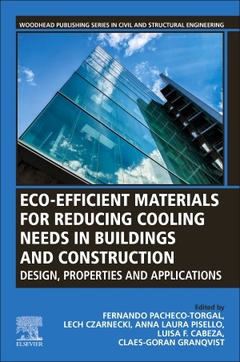Eco-efficient Materials for Reducing Cooling Needs in Buildings and Construction Design, Properties and Applications Woodhead Publishing Series in Civil and Structural Engineering Series
Coordonnateurs : Pacheco-Torgal Fernando, Czarnecki Lech, Pisello Anna Laura, Cabeza Luisa F., Goran-Granqvist Claes

1. Introduction
PART I. PAVEMENTS FOR MITIGATING URBAN HEAT ISLAND EFFECTS 2. High albedo Pavements 3. Performance of thermochromic asphalt 4. Pavements withn PCMs
PART II. FACADE MATERIALS FOR REDUCING COOLING NEEDS 5. Quantitative approximation of shading-induced cooling by climber green wall based on multiple-iterative radiation pathways 6. Experimental study on geometric configuration and evaporative cooling potential of brick elements 7. A geothermal and an evaporative system for building walls 8. Cooling techniques in reducing overheating of clay-straw building in semi-arid climate 9. Multi-layer glass and BIPV facade structures
PART III. ROOFING MATERIALS FOR REDUCING COOLING NEEDS 10. Green roofs as passive system to moderate buildings cooling requirements and UHI effects: assessments by means of experimental data 11. Thermal evaluation of building roofs with conventional and reflective coatings 12. Active and passive systems for cool roofs
PART IV. PCMS AND SWITCHABLE GLAZING BASED MATERIALS FOR REDUCING COOLING NEEDS 13. Bio based PCMs for reducing cooling needs 14. Performance of bricks with PCMs in India 15. Influence of novel PCMs based strategies on building cooling 16. Optically smart thin material for building cooling 17. An overview of the performance of thermochromic glazing 18. Performance of thermochromic windows
Researchers, architects and civil engineers, city planners and product developers and manufacturers and other professional working in wco-efficient cooling materials and sustainable and zero energy building design.
Dr. F. Pacheco-Torgal is a principal investigator at the University of Minho, in Portugal. He currently holds the title of Counsellor from the Portuguese Engineers Association and has authored more than 300 publications. He is a member of the editorial boards for 9 international journals. He has acted as a foreign expert in the evaluation of 30 PhD theses. In the last 10 years he has been a Member of the Scientific Committee for almost 60 conferences most of them in Asian countries. He is also a grant assessor for several scientific institutions in 15 countries including the UK, US, Netherlands, China, France, Australia, Kazakhstan, Belgium, Spain, Czech Republic, Chile, Saudi Arabia, UA. Emirates, Croatia, Poland, and the EU Commission. He has also been an invited reviewer for 125 international journals and has reviewed almost 1200 papers and has been the lead editor of 27 books.
Prof. Lech Czarnecki PhD, D.Sc. – is the Scientific Secretary of Building Research Institute, ITB, former the Head of the Building Materials Engineering Department of (1981-2011) and the Vice-Rector for academic affairs ( 2002 – 2005 ) of Warsaw University of Technology. He was the President of International Congress on Polymers in Concrete (2006-2011). Professor was awarded “for eminent activities in new frontiers of building materials engineering by the Society of Materials Engineering for Resources of Japan in 2009 and “for distinguished service and leadership in the field of polymers in concrete Owen Nutt Award in 2004.Author of more than 250 publications and Department editor of Bulletin of Polish Academy Science Technical Science.
Chemical engineer from the Institut Químic de Sarrià in 1992, industrial engineer from University Ramon Llull in 1993, master in industrial business management in 1995, and doctor industrial engineer in 1996 from the same university. Post-doctoral researcher at the Eastern Regional Research Center (ARS, USDA) in Philadelphia, USA bet
- Offers a comprehensive review of building envelope materials and technologies for reducing cooling needs
- Features practical case studies, which are fundamental for building design and applications
- Provides in-depth analysis of performance for different materials and technologies
- Features brand new chapters on pavements, facade and roofing materials, PCMs and chromogenic smart materials
Date de parution : 10-2020
Ouvrage de 484 p.
15x22.8 cm
Thème d’Eco-efficient Materials for Reducing Cooling Needs in... :
Mots-clés :
Adaptive materials; Aging; All-glazed façade structures; Asphalt; Attic temperature; Biobased; Brick patterns; Building; Building cooling needs; Building design; Building energy performance; Building integrated photovoltaic; Building roofs; Climate emergency; Computational fluid dynamics; Cool roof; Cooling; Cooling demand limitation; Cooling loads; Cooling system; Deep adaptation; Distributed and coupled systems; Electrochromic; Embodied energy; Energy cost analysis; Energy economy; Energy efficiency; Energy performance; Evaporation; Evaporative cooling; Fatigue; Fenestrated building envelope; Global warming; positive feedback cycles; Green roof; Green wall; Ground cooling; Heat waves; Hemp plaster; Hydronic pavement; Innovative cool materials; Integrated building performance simulation; Intelligent control strategies; Material characteristic; Mitigating; Moving air cavity; Multilevel uncertainty-based analysis; Novel PCM-integrated forms; nZEB; Office building; Optimizations; Passive cooling; Passive system; Pavement; Pavement temperature adjustment; PCM pavement; Phase change material (PCM); Phase change materials; Phase changed materials; Porous pavement; Radiative properties; Real-time dynamic absorptivity; Reduction of cooling peak power; Reflective coatings; Reflective pavement; Refurbishment; Retrofit; Revised radiation apportionment model; Rutting; Self-shading bricks; Shading-induced cooling; Smart glazing; Smart roofs; Smart walls; Smart windows; Surface temperature; Thermal behavior; Thermal comfort; Thermal reflective coating; Thermochromic; Thermochromic asphalt binder; Thermochromic glazing; Thermochromic materials; Thermochromic microcapsules; Transparent adaptive façades; UHI; Urban heat island; Visual comfort


